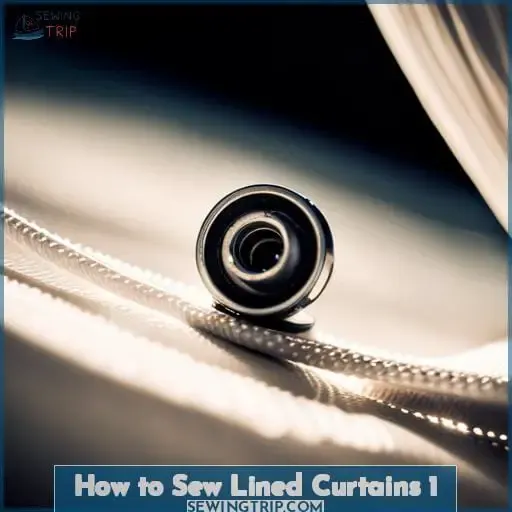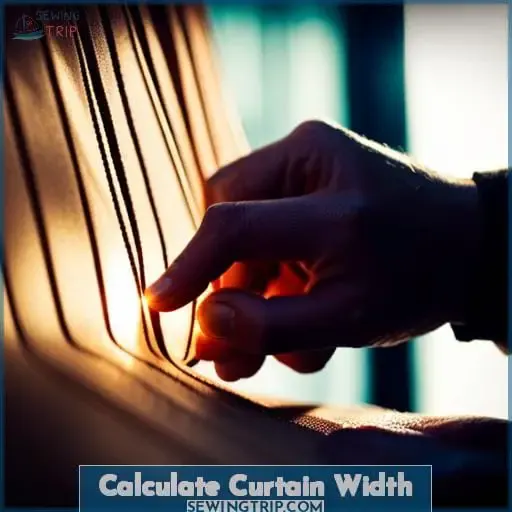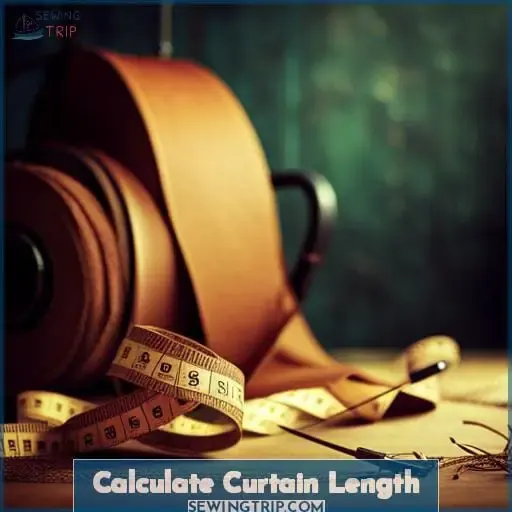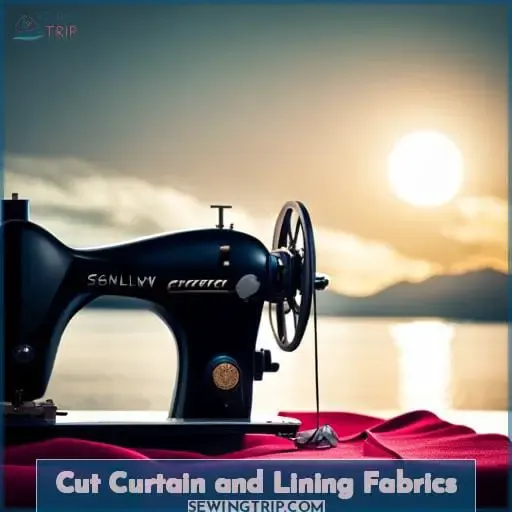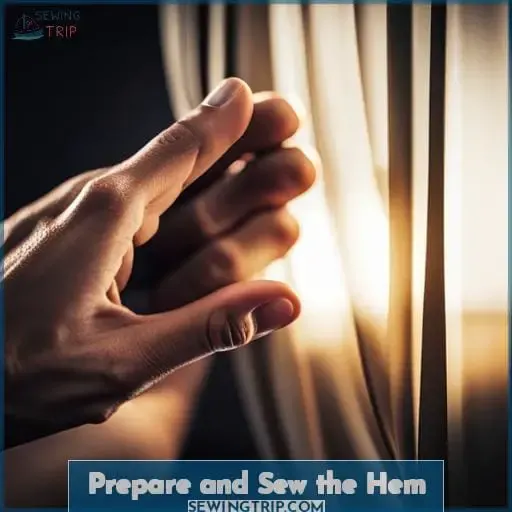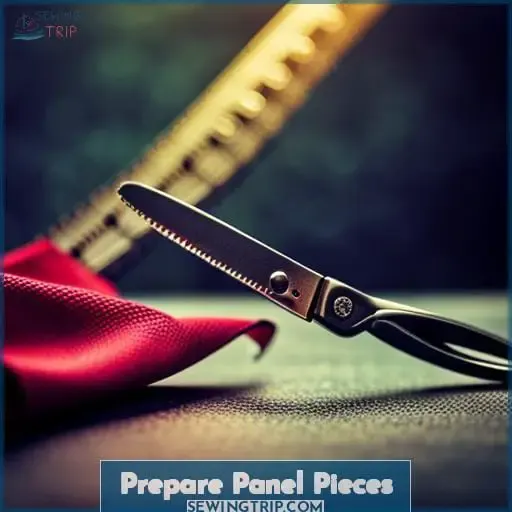This site is supported by our readers. We may earn a commission, at no cost to you, if you purchase through links.
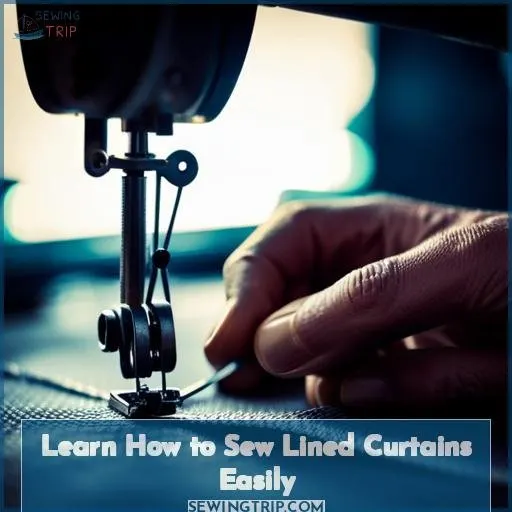
Did you know that about 70% of people prefer to make their own curtains rather than buying them from a store?
It’s time for you to join the DIY trend and learn how to sew lined curtains.
Making your own custom-made, lined and pleated drapes is easy with basic sewing skills!
With this tutorial, you’ll be able to measure your window size correctly, cut fabrics accurately as well as prepare panel pieces.
You will also learn how to insert weights into hemming along with connecting fabric and lining together – all in an effortless way.
So let’s get started on learning the easiest technique for making beautiful homemade lined curtains!
Table Of Contents
Key Takeaways
- 70% prefer making their own curtains
- Tutorial for measuring window size, cutting fabrics, and preparing panel pieces
- Basic sewing supplies needed: chalk, thread
- Choose fabric that matches the space, considering the time investment
Simple Lined Grommet Curtains
Making custom curtains takes some know-how and the right materials. To get started, you’ll need fabric, lining, chalk for measurements, a curtain rod with rings or grommets of your choice. Prep work includes measuring your window to determine length and width, as well as cutting both fabrics to size before hemming them up separately and attaching the lining to the fabric itself.
What You Need
To create your own custom curtains, you’ll need fabric that matches the space, curtain rings, and a rod for hanging, plus basic sewing supplies like chalk and thread.
Measure windows carefully to determine the width and length of each panel. Add 10 inches for hemming.
Header tape can be used if desired, but traditional double hems are preferred with grommet curtains.
Select blackout lining to block out light or opt for sheer fabrics without it.
Seam allowance should be added when attaching lining fabric so corners can be mitered neatly at the bottom edge.
With these materials in hand, you’re ready to start crafting beautiful one-of-a-kind window treatments!
Prep Work
Before starting your project, measure the windows carefully and make sure you have all of the necessary materials. The process will go much faster if you do! It usually takes about five hours to complete a lined curtain project.
Select fabric that works with your space, then use chalk to mark right sides together for cutting panels according to desired dimensions plus added hem allowance. Create top and bottom hems on both fabric panel and lining before attaching them together using basic sewing skills.
Experiment with different customizing options such as grommets or back-tabs when hanging curtains.
Calculate Curtain Width
Calculate the perfect width for your curtains and enjoy a luxurious look that will completely transform any room.
- Measure the entire width of your window to determine how wide each fabric panel should be.
- Traditional curtains are 1.5 times the width of the window, so divide this measurement in half when selecting fabric panels individually or double it if making two separate panels per side of the window frame.
- Add 10 inches for hemming on both sides – this is necessary for creating clean edges and mitered corners when attaching lining later on!
- Choose a fabric that matches or complements your space, keeping in mind the time investment (longer fabrics may require extra steps).
- Hang with rings or grommets depending on preference – curtain rods can also provide an elegant finish if desired!
With these measuring tips, you’ll have custom lined curtains up in no time at all!
Calculate Curtain Length
Now that you’ve calculated the perfect width for your curtains, it’s time to measure and cut the fabric.
Using a tape measure, determine how long each panel should be by measuring from the top of the window frame (or where the curtain rod will hang) down to the desired length on the floor or sill.
When selecting fabric, choose one with blackout lining if needed. This will help block out light while providing a soft drape.
For traditional mitered corners at the bottom of the panels when attaching the lining later on, make sure the total length is 1-2 inches shorter than the window sizing.
Once everything is cut and ready-to-go, take extra care when placing the wrong side up.
With these tips in mind, you can easily create custom lined curtains that are perfect for any room in your home!
Cut Curtain and Lining Fabrics
Once you’ve got your fabrics cut to size, it’s time to start hemming! Measurement tips and fabric selection are key when creating custom lined curtains.
Begin with the main fabric of your curtains – fold the bottom edge twice and press. Then, using a needle and thread, sew along either side of the folded panel for secure hemming basics.
For mitered corners at the bottom of each curtain panel (including any blackout lining selected), tuck in one corner before sewing across both layers together from end-to-end for a neat finish.
If desired, attach grommet centers on top or use back tabs instead – this is an easy way to open/close them as needed over time!
Once complete with two panels finished separately in this manner; line up both pieces wrong sides facing each other then stitch around all edges except hems on top until reaching left & right bottom corners – where they should be turned inside out prior proceeding further stitching those parts too including mitered ones if applicable.
Finally, hang up onto rods or rings after ironing lightly ensuring a perfect look that will last long!
Prepare and Sew the Hem
Next, fold and press the hems on both your curtain fabric and lining to get them ready for sewing.
Begin with the main fabric of your curtains – fold the bottom edge twice and press using a needle and thread.
To make mitered corners at the bottom of each panel, tuck in one corner before using serging techniques across both layers together from end to end for an impressive finish.
When it comes to installation, you can choose between grommet centers or back tabs; either will be easy when opening/closing over time!
Create a neat top hem by folding it over once more before stitching it down with a sewing machine.
Afterwards, a double-folded hem is done on all edges except the hems at the top.
Line up the wrong sides facing each other, then stitch around all outer parts, including the left and right sides’ mitered ones if necessary.
This allows for turning inside out prior to hanging onto rods or rings as desired after lightly ironing!
Curtain rod installation and the selection of curtain rings or grommets are two important steps when making custom lined curtains that reflect style based on chosen fabric pieces combined with proper measurements – resulting in a luxurious space that everyone would love living in!
Prepare Panel Pieces
Before starting to sew, prepare the panel pieces by cutting your curtain fabric and lining according to the desired measurements. Measurement accuracy is essential for a professional-looking finish, so make sure to double-check that you have cut the right side of each panel.
Follow cutting instructions specific to your fabric selection. Place it on a flat surface, pin it in place as necessary, and carefully cut it out with scissors or a rotary cutter.
For hem options, fold it over once for an additional half inch before stitching along both edges of the top hems.
If desired, you can also miter the corners at the bottom edge. Tuck one corner inside before securing them together using serging techniques across all sides from end to end.
Attach the lining fabric underneath the main curtain piece after folding up its own edges twice.
Sew the Side Seam
Now, attach the lining fabric to the main curtain piece by stitching together both sides from end to end. Sewing techniques vary depending on your fabric choice. For example, you can use mitered corners at the bottom edge for a neat finish while leaving enough space for grommet installation.
Alternatively, you may choose to fold up and add a top hem instead of using curtain rings along with blackout lining if desired.
To get started, position the left side of the window panel in front and line it up properly before beginning to stitch on each side of each panel until reaching its edges. Make sure that all hems are carefully folded beforehand so that no raw edges are exposed when attaching them together.
Insert Weights and Sew Hem
You can make your curtains look even more luxurious by adding weights to the bottom hem and sewing it in place. Drapery weights are a great way to ensure your fabric hangs correctly, providing better light-blocking capabilities.
Fabric selection is key for achieving this effect; heavier fabrics require additional weight while lighter fabrics may not need any at all! To add drapery weights, start by folding up the hem of the curtain fabric along with any lining material that’s been attached.
For best results, use heavy-duty thread when stitching as this will help keep everything secure! Additionally, be sure to follow specific tips on how to sew hems for both materials used during fabrication.
With careful attention to detail and patience throughout each step involved in making custom lined curtains, you’ll be able to create beautiful window treatments that will last for years!
Hem the Lining
Once the curtain fabric is hemmed, it’s time to tackle the lining.
To begin, measure and cut out enough material for both curtains according to your desired length. For an extra touch of elegance, add a few inches more on each side than what you need so that any mitering at corners looks neat and seamless when hung.
With basic sewing skills or some help from a friend who knows how to sew, use a zig-zag stitch along one long edge of the right sides together with no backstitching before pressing open this sewn seam flat on both sides of your fabric pieces as well as for any hemming needed around other edges.
Be sure to consider which hanging option best suits your needs during fabrication; grommets or backtabs are popular choices but don’t forget about adding weights at bottom hems if using heavy fabrics!
Adding blackout linings will block out light while giving an extra layer of warmth in colder temperatures – just be sure not to have too much excess fabric here when cutting since they can become bulky after being sewn onto main panels!
With careful attention given throughout each step involved in making custom lined curtains, following these tips will result in beautiful window treatments that last years down the line!
Connect Fabric and Lining
Connect the fabric and lining to create a luxurious space with one simple stitch, creating an elegant mitered corner like a perfect puzzle piece.
Choosing the right fabric for your curtains is essential – opt for something that matches your space and complements other décor.
Linings should also be taken into consideration; blackout linings are great for blocking out light while giving warmth in colder temperatures.
Hem details will take some time but are worth it in order to achieve neat edges on each side of both fabrics before you begin connecting them together.
To miter corners, fold raw edges inward at a 45° angle, then tuck beneath the hemmed edge before stitching into place.
Finish off the top edge by folding down about 1/2 or more towards the wrong side of the curtain, then press flat with an iron if needed so single-fabric curtains can hang nicely when using a grommet guide or clip curtain rings!
Frequently Asked Questions (FAQs)
What type of rod should I use for my curtains?
Choose a curtain rod that fits your style and gives the curtains an elegant touch. A decorative, metal or wooden rod will stand out in any room while adding texture to your window treatment. For added luxury, use finials for a chic look that will transform your space into one of opulence and sophistication.
How do I create a neat edge on the bottom of the curtains?
Fold and stitch the bottom of the curtain fabric like a crisp, folded shirt collar; miter corners by tucking and stitching. Create an elegant finish with a neat edge on top. The result will be as smooth as glass.
What is the best way to hang curtains?
Hang your curtains with rings for easy opening and closing. Create a luxurious look by adding mitered corners at the bottom, then use back tabs or grommets to add sophistication to the space.
What kind of fabric should I use for lined curtains?
Choose a fabric that is both stylish and durable. Consider cotton, linen, or velvet for your lined curtains – all of which provide insulation from light and have a soft drape. Pick colors that will match the space you are decorating to create an inviting atmosphere.
How much fabric do I need for a pair of lined curtains?
You’ll need fabric that is 5 times the width of your window and 10 inches longer than the length for hemming.
Conclusion
Creating your own curtains can be like painting a masterpiece. With the right fabric, measurements, and sewing techniques, you can create beautiful, luxurious curtains with a custom fit for your home. The process may take some time, but the end result will be worth it. You’ll be able to enjoy the perfect curtains for your space that you made yourself.

